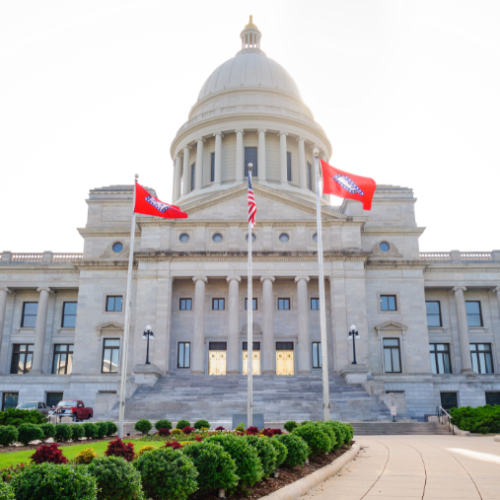
Updated April 23, 2021
Vermont Governor Phil Scott recently signed a bipartisan criminal justice bill designed to reduce recidivism and dissect racial disparities in the state’s prisons. As a result, the state is expected to avert up to more than $13 million in corrections costs by fiscal year 2025.
The policy changes are the result of Vermont’s Justice Reinvestment Initiative (JRI), which the state embarked on in 2019 with intensive technical support from experts at The Council of State Governments (CSG) Justice Center. Here’s what you need to know:
1. Why is this legislation needed?
Like other states, each year Vermont grapples with high rates of people being removed from community supervision and sent to prison. Nearly 80 percent of all prison admissions in Vermont were for violations of terms of furlough, probation, or parole supervision from 2017 to 2019. The majority of people who returned to prison for violating the terms of their furlough release did so due to technical violations, which frequently consist of minor offenses, such as a lack of housing, failed drug tests, or missed appointments and curfews.
Vermont also faces significant racial disparities within the criminal justice system. Black people make up just 1.3 percent of Vermont’s general population, but they represent 7 percent of people sentenced to the state’s correctional facilities.
2. What will the legislation do?
Act 148 is aimed at reducing Vermont’s high recidivism rates by restructuring the state’s approach to community supervision, while also launching a focused effort to examine racial disparities in sentencing and in Vermont’s prisons. Ultimately, the state’s prison population is projected to decrease by more than 100 people, saving the state millions in corrections costs.
A system of presumptive parole will be implemented.
Presumptive parole will allow people to be released to supervision if they meet their minimum sentence requirement and key criteria related to good behavior while incarcerated. The legislation requires the Parole Board to conduct a review of all presumptive parole candidates within 30 days of the person’s eligibility date. The board can deny presumptive release if it determines that a victim should be notified and given the chance to participate in a hearing.
The furlough system will be streamlined.
Seventeen types of furlough will be reduced to 10 statuses. This consolidation will create a new primary furlough status, Community Supervision Furlough, which will be the main release mechanism for people who are ineligible for presumptive parole as well as those who have been revoked to prison from community supervision. Other statuses will be streamlined including Temporary Furlough, which allows people to be released from incarceration for short-term reasons, and Treatment Furlough, which is designed for people who require residential treatment services.
The legislation also creates a review process within the Department of Corrections for revoking or interrupting furloughs for more than 90 days.
New reporting related to demographics and sentencing will be required.
The legislation requires a range of analysis related to demographics and sentencing that are designed to help Vermont better identify and reduce racial disparities in the criminal justice system, including identifying the types of offenses where racial disparities exist or are exacerbated.
Other key elements of the bill:
- Further incentivizing good behavior among people who are incarcerated or on furlough by increasing the number of days per month—from five to seven—that a person can earn off their incarceration term
- Requiring additional information to be collected and reported about the use of the Department of Corrections’ graduated sanctions policy, which allows up to five days of reincarceration for people on community supervision who have violated the terms of their supervision
- Directing the Agency of Human Services to share how it identifies people in the criminal justice system who have behavioral health needs and where gaps exist in the process to identify those individuals
- Directing the Department of Corrections to report on its efforts to implement a housing screener to better identify the housing needs among the incarcerated population.
3. How was the legislation developed?
Vermont successfully used a JRI approach in 2007 to address a projected 24-percent increase in the state’s prison population by 2018. Since the enactment of 2008 JRI legislation, that increase has been avoided, and the state’s prison population has declined 17 percent.
In 2019, the state embarked on a second round of JRI to build on prior efforts and address new challenges related to community supervision and recidivism with intensive technical assistance from the CSG Justice Center and support from The Pew Charitable Trusts and the U.S. Department of Justice’s Bureau of Justice Assistance. The Vermont Justice Reinvestment II Working Group—which included stakeholders from all three branches of government—worked with CSG Justice Center staff to review analyses and develop policy options, which are reflected in the legislation.
4. What are Vermonters saying?
This project was supported by Grant No. 2015-ZB-BX-K001 awarded by the Bureau of Justice Assistance. The Bureau of Justice Assistance is a component of the Department of Justice’s Office of Justice Programs, which also includes the Bureau of Justice Statistics, the National Institute of Justice, the Office of Juvenile Justice and Delinquency Prevention, the Office for Victims of Crime, and the SMART Office. Points of view or opinions in this document are those of the author and do not necessarily represent the official position or policies of the U.S. Department of Justice.
About the Authors


Arkansas policymakers have long expressed concerns about the state’s high recidivism rate. Over the past 10 years, an…
Read MoreIn April 2025, Arkansas Governor Sarah Huckabee Sanders signed a package of bipartisan criminal justice legislation into law,…
Read More Explainer: Key Findings and Options from Arkansas’s Justice Reinvestment Initiative
Explainer: Key Findings and Options from Arkansas’s Justice Reinvestment Initiative
Arkansas policymakers have long expressed concerns about the state’s high recidivism rate.…
Read More Explainer: How a New Law in Arkansas Tackles Crime, Recidivism, and Community Supervision Challenges
Explainer: How a New Law in Arkansas Tackles Crime, Recidivism, and Community Supervision Challenges
In April 2025, Arkansas Governor Sarah Huckabee Sanders signed a package of…
Read More









